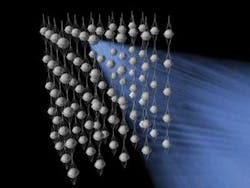PHOTOMULTIPLIER TUBES: Optical modules detect high-energy neutrinos
Over the next five years, an international research team led by Francis Halzen, a University of Wisconsin-Madison professor of physics, intends to place a total of 4200 digital optical modules (DOMs) within a cubic kilometer of ice buried more than a mile beneath the Antarctic ice cap to serve as the collecting mirror for a neutrino telescope, dubbed “IceCube.” The DOMs are strung together in groups of 60 along vertically suspended electrical cables. During the most recent Antarctic summer season, lasting from mid-October to mid-February, the first 60-DOM IceCube cable was lowered into a hole drilled through the Antarctic ice using jets of hot water.
Produced by the decay of radioactive elements and elementary particles from the Milky Way and beyond, neutrinos are electrically neutral and have negligible mass, so they are unaffected by magnetic fields and seldom interact with other particles. In fact, neutrinos are the only particles known to pass through the Earth. Therefore, IceCube is directed toward northern skies from its Antarctic station to use the planet as a filter for everything but the trillions of neutrinos that pass undetected through every square centimeter of the Earth’s surface every second.
Occasionally, however, one of these neutrinos will collide with an atom to generate a muon, which emits bluish Cerenkov radiation on passing through ice or water. IceCube’s DOMs can detect and analyze this radiation enabling researchers to characterize the neutrino that caused it. IceCube is designed to study high-energy neutrinos spawned in violent astrophysical events, such as supernovas and gamma-ray bursts, in hopes of eventually producing a map of the neutrino sky and gaining insight into astrophysics questions such as the nature of dark matter and the origin of cosmic rays.
Each DOM consists of a glass sphere the size of a basketball that houses a photomultiplier tube, as well as control, processing and communications hardware and software, which was designed by researchers at Lawrence Berkeley National Laboratory (LBNL; Berkeley, CA). “Each of these DOMs is like a mini-computer server that you can log onto and download data from, or upload software to,” said Robert Stokstad, who leads the IceCube effort at LBNL. IceCube data are collected with a custom waveform-digitizer chip, and the photomultiplier-tube waveform is sampled 128 times at 300 megasamples per second.
IceCube is an international collaborative effort of more than 150 scientists, engineers, and computer scientists from 26 institutions in the United States, Europe, Japan and New Zealand. Construction of IceCube is projected to cost $272 million. The National Science Foundation will provide $242 million for the project, and an additional $30 million will come from foreign partners.
About the Author
Hassaun A. Jones-Bey
Senior Editor and Freelance Writer
Hassaun A. Jones-Bey was a senior editor and then freelance writer for Laser Focus World.
